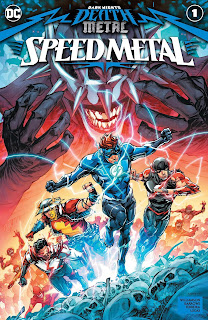Gods and Monsters
Brian Michael Bendis and David Walker Writers
Scott Godlewski Art
Gabe Eltaeb Colors
Wes Abbott Letters
John Timms and Gabe Eltaeb Cover
Francis Manapul Variant Cover
Bixie Mathieu Assistant Editor
Brittany Holzherr Editor
Jamie S. Rich Group Editor
Superboy created by Jerry Siegel.
By special arrangement with the Jerry Siegel family.
Our cover shows Wonder Girl challenging Zeus ... even though he’s behind her ... while she’s wielding a golden lasso ... which she never has had in this series ... and standing on a Wonder Woman seal with a random broken column behind her. Timms is a great artist, but this is just a weird cover. Yeah, the energy and the emotion is right, and I guess that’s the most important thing. But the more I look at this cover, the odder it becomes.
Our variant cover is by one of my all-time favorites, Francis Manapul. And this is a delightful, light-hearted image of our team. Unfortunately, it does illustrate some of the main problems these variant cover artists have had with Young Justice. Nobody really knows who’s officially on the team (sorry Amethyst and Wonder Twins, you don’t belong here), and nobody really knows what Impulse’s costume is supposed to look like (although I will always advocate for the fingerless gloves).
Our story begins with a new recap page, presented as an Ancient Greek scroll beneath a picture of Zeus dramatically appearing before Cassie. Here’s what it says:
“Robin, Superboy, Impulse, Wonder Girl, Jinny Hex, Naomi, and Teen Lantern have come together and taken down the once great, but now evil science corporation S.T.A.R. Labs! (I’m convinced that David Walker wrote that line. There’s no way Bendis knew S.T.A.R. Labs was supposed to be good.)
“In doing so, the entire group found out a lot of things about their past and their responsibilities to the future and each other.
“On the road to finding herself, Cassie Sandsmark, a.k.a. Wonder Girl, has shaken off some of her responsibilities to the Pantheon.
“Her grandfather Zeus is not pleased.”
What follows next is a rather sloppy attempt at condensing what must have been a planned six-issue story into just one issue. So let’s just skip ahead to Wonder Girl meeting up with Young Justice at an outdoor cafe in Central City. Last issue didn’t indicate that the team went to Central City to celebrate Spoiler’s victory over Cluemaster and Tim’s decision to become Robin again. Last issue also clearly showed that Wonder Girl was forcefully blasted over to her teammates, creating a small crater in the road when she landed. But this issue showed she calmly flew over there under her own power, after having defeated a random large monster.
Cassie orders a hamburger and tells her team that she’s the granddaughter of Zeus, who wants her to join the Pantheon of Gods. But nobody understands why this has Cassie so upset. Bart even jokes that he’s known Cassie for 79 years and he still doesn’t get it. Cassie tries to explain herself, only lamely coming up with “Zeus makes no sense to me. I don’t get it. Does that make any sense?” Her friends are supportive, but they do have follow-up questions about the exact nature of being in the Pantheon. Before Cassie can contemplate this subject that she seems to know nothing about, Bart notices a large oceanic event heading their way ... even though they’re in Central City.
Turns out it’s Poseidon, who was just messing with Zeus. Young Justice quickly defeat Poseidon and his sea monsters on a single splash page, thanks mostly to the magic sword Zeus gave Cassie. Yeah, since Amethyst is gone, I guess we needed another girl with a magic sword. Anyway, Zeus shows up to congratulate Cassie and again offer her a spot on the Pantheon. She refuses him once more — for no reason — and when Zeus threatens her with banishment, Wonder Girl and Young Justice strike a dramatic fighting pose. But Zeus just says, “So be it,” and teleports away in a flash of lightning. Wonder Girl looks up to the sky and smiles, as a single tear runs down her cheek.
In the movie Space Balls, an exasperated priest is trying to conduct a wedding ceremony, but keeps getting interrupted. Ultimately, he delivers what he calls the “short short version.” This is the short short version of Bendis’ Wonder Girl story. And it’s a shame, since Wonder Girl has always been shorted by DC. Unlike Robin, Superboy and Impulse, Wonder Girl never had her own monthly series beyond a couple of specials and limited-issue runs. And here, with everything crammed together so quickly and forcefully, the story loses all the impact it could have had. We never understand what being in the Pantheon actually means or why Cassie refuses to join it. The magic sword completely came out of nowhere, as well as Poseidon’s involvement.
Frankly, this issue never should have been attempted. With the series ending at issue 20, #19 should have focused on setting up a satisfying ending. This Wonder Girl story should have been fleshed out in a separate 6-issue miniseries — if Bendis could have used his clout to launch yet another miniseries. Barring that, he could have at least given his outline to the Wonder Woman team and begged them to tell his story. As such, we were left with yet another disappointing issue leading to the conclusion of this short-lived, disappointing series.
Here are the new house ads:
The darkest night rises. The multiverse falls. History will be rewritten. Dark Nights: Death Metal Rise of the New God.
The most sadistic 10-year-old in existence! Dark Nights: Death Metal Robin King.
DC Nation spotlight on teen wonders.
Next: Final Justice.




